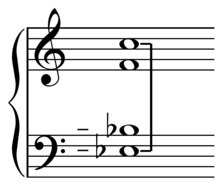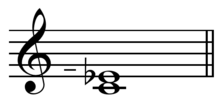Minor third
Inverse | major sixth |
|---|---|
| Name | |
| Other names | sesquitone |
| Abbreviation | m3 |
| Size | |
| Semitones | 3 |
| Interval class | 3 |
| Just interval | 6:5, 19:16, 32:27[1] |
| Cents | |
| 12-Tone equal temperament | 300 |
| Just intonation | 316, 298, 294 |


In
Notable examples of ascending minor thirds include the opening two notes of "Greensleeves" and of "Light My Fire".
The minor third may be derived from the harmonic series as the interval between the fifth and sixth harmonics, or from the 19th harmonic.
The minor third is commonly used to express sadness in music, and research shows that this mirrors its use in speech, as a tone similar to a minor third is produced during sad speech.
The
A minor third, in
Other pitch ratios are given related names, the septimal minor third with ratio 7:6 and the tridecimal minor third with ratio 13:11 in particular.
The minor third is classed as an imperfect consonance and is considered one of the most consonant intervals after the unison, octave, perfect fifth, and perfect fourth.
The
Pythagorean minor third

In
It can be thought of as two
See also
References
- ISBN 0-8247-4714-3. 19th harmonic, overtone minor tone.
- PMID 20515223.
- ISBN 9781317614203. "The minor third, however, does not appear in the harmonic series until the nineteenth harmonic. Your ear almost expects to hear the major third ([on A:] C♯), and when that is replaced with a more distantly related note, this makes the listener feel more 'unpleasant', 'tense', or 'sad'."
- ISBN 1-143-49451-2.
- ^ Prout, Ebenezer (December 1, 1908). "In the Forecourts of Instrumentation", The Monthly Musical Record. p. 268.
- ^ John Fonville. "Ben Johnston's Extended Just Intonation – A Guide for Interpreters", p. 124, Perspectives of New Music, vol. 29, no. 2 (Summer 1991), pp. 106-137.
- ^ Paul, Oscar (1885). A manual of harmony for use in music-schools and seminaries and for self-instruction, p. 165. Theodore Baker, trans. G. Schirmer.


